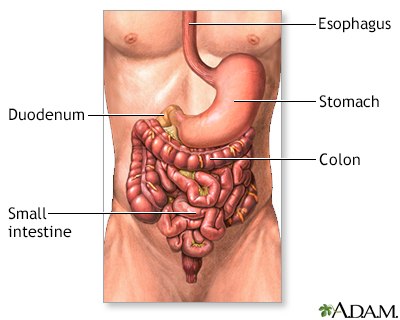Bowel transit time
Bowel transit time refers to how long it takes for the food to move from the mouth to the end of the intestine (anus).
This article talks about the medical test used to determine bowel transit time using a radiopaque marker testing.
Images

How the Test is Performed
You will be asked to swallow multiple radiopaque markers (show up on x-ray) in a capsule, bead, or ring.
The movement of the marker in the digestive tract will be tracked using x-ray, done at set times over several days.
The number and location of markers are noted.
How to Prepare for the Test
You may not need to prepare for this test. However, your provider may recommend you follow a high-fiber diet. You will likely be asked to avoid laxatives, enemas, and other medicines that change the way your bowels function.
How the Test will Feel
You will not feel the capsule move through your digestive system.
Why the Test is Performed
The test helps determine bowel function. You may need this test done to evaluate the cause of constipation or other problems involving difficulty passing stool.
Normal Results
The bowel transit time varies, even in the same person.
- The average transit time through the colon in someone who is not constipated is 30 to 40 hours.
- Up to a maximum of 72 hours is still considered normal, although transit time in women may reach up to around 100 hours.
What Abnormal Results Mean
If more than 20% of the marker is present in the colon after 5 days, you may have slowed bowel function. The report will note in what area the markers appear to collect.
Risks
There are no risks.
Considerations
The bowel transit time test is rarely done these days. Instead, bowel transit is often measured with small probes called manometry. Your provider can tell you if this is needed for your condition.
Related Information
FiberReferences
Camilleri M. Disorders of gastrointestinal motility. In: Goldman L, Schafer AI, eds. Goldman-Cecil Medicine. 26th ed. Philadelphia, PA: Elsevier; 2020:chap 127.
Iturrino JC, Lembo AJ. Constipation. In: Feldman M, Friedman LS, Brandt LJ, eds. Sleisenger and Fordtran's Gastrointestinal and Liver Disease. 11th ed. Philadelphia, PA: Elsevier; 2021:chap 19.
Rayner CK, Hughes PA. Small intestinal motor and sensory function and dysfunction. In: Feldman M, Friedman LS, Brandt LJ, eds. Sleisenger and Fordtran's Gastrointestinal and Liver Disease. 11th ed. Philadelphia, PA: Elsevier; 2021:chap 99.
BACK TO TOPReview Date: 7/30/2022
Reviewed By: Michael M. Phillips, MD, Emeritus Professor of Medicine, The George Washington University School of Medicine, Washington, DC. Also reviewed by David C. Dugdale, MD, Medical Director, Brenda Conaway, Editorial Director, and the A.D.A.M. Editorial team.

Health Content Provider
06/01/2025
|
A.D.A.M., Inc. is accredited by URAC, for Health Content Provider (www.urac.org). URAC's accreditation program is an independent audit to verify that A.D.A.M. follows rigorous standards of quality and accountability. A.D.A.M. is among the first to achieve this important distinction for online health information and services. Learn more about A.D.A.M.'s editorial policy, editorial process and privacy policy. A.D.A.M. is also a founding member of Hi-Ethics. This site complied with the HONcode standard for trustworthy health information from 1995 to 2022, after which HON (Health On the Net, a not-for-profit organization that promoted transparent and reliable health information online) was discontinued. |
The information provided herein should not be used during any medical emergency or for the diagnosis or treatment of any medical condition. A licensed medical professional should be consulted for diagnosis and treatment of any and all medical conditions. Links to other sites are provided for information only -- they do not constitute endorsements of those other sites. © 1997- 2024 A.D.A.M., a business unit of Ebix, Inc. Any duplication or distribution of the information contained herein is strictly prohibited.
